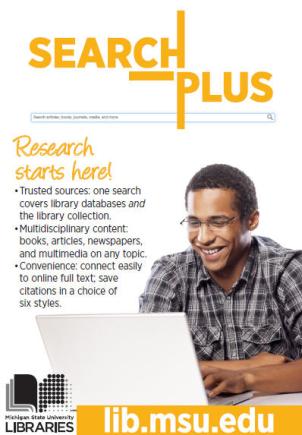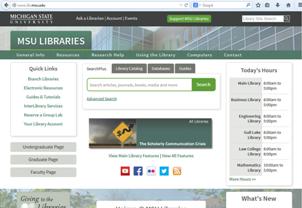
This is the first of an LJ “Rollout” series on webscale discovery solution implementations.
In an effort to cater to the growth of interdisciplinary research while also simplifying the search experience for undergraduates, the Michigan State University Libraries (MSU) this month debuted Summon from ProQuest as its first web scale discovery service. Branded as SearchPlus by MSU, the discovery layer will offer students and researchers a single entry point for searching the majority of the library’s resources.
“We were seeing confusion among library users, who found it very difficult to choose well among literally hundreds of ‘silos’ devoted to specific kinds of information (OPAC for books, MLA index for literature studies, SciFinder for chemistry articles, etc.),” Steven Sowards, MSU libraries associate director for collections, told LJ regarding MSU’s decision to implement a discovery solution. “This was especially a problem for first-year students, who might have no experience with searching except through a Google-like platform.”
In addition to making searching a more intuitive experience, implementing a discovery solution gives students and researchers a better view of the range of resources available at MSU libraries, and helps “support searching across publications in multiple disciplines,” Sowards explained.
“Scholars are trained in their disciplines to know what are the primary and most important resources,” added Michael Rodriguez, collections coordinator for the humanities, noting that there used to be semester-long classes on these resources at the graduate student level in many disciplines. “But now so much scholarship, especially at a land-grant [university] like MSU, is interdisciplinary, and a resource overlay like Summon introduces scholars to many of the main resources they probably wouldn’t know about outside of their main field of study.”
A search for the term “Postmodernism,” for example, will return results for resources in music, philosophy, art, architecture, education, and other fields, Rodriguez said. “In addition researchers are pointed to ‘Related Topics’ and a choice of specific ‘Discipline’ under ‘Refine Your Search’—something library catalogs don’t do very well in organizing information.”
Recent Summon training for library staff has taken interdisciplinary research into account, Sowards said.
“For example, while we realize that CINAHL [Cumulative Index to Nursing and Allied Health] continues to be the preferred discipline-specific indexing tool for nursing topics, there are cross-disciplinary tie-ins that Summon can help uncover: think about national public health policy, or gender issues in the professions, or environmental impacts on wellness,” Sowards said. “We want our subject librarians to be prepared to talk with campus faculty about instances when Summon might offer complementary searching capacities. And there are many hot research topics for which there is no single ‘best’ indexing and abstracting tool: water resources, or alternative fuels, or biometrics, to name a few. Summon can serve those emerging areas.”
MSU libraries evaluated several discovery solutions, ultimately opting for Summon, in part, because of the university’s substantial existing investments in other ProQuest products. MSU was using Serials Solutions as a knowledge base to manage electronic collections and offers resources such as ProQuest Dissertations in full text, U.S. government publications, and ProQuest Historical Newspaper backfiles. Said Sowards, “Summon was able to provide full discovery for those resources, including article-level newspaper coverage.”
In addition, the library believed that Summon’s proprietary master index would best enable non-students to search library holdings and view citations, even though access to licensed full-text content will still be limited to authenticated MSU students and faculty.
“As the library serving the pioneer land grant university, we take seriously our capacity to make all residents of Michigan (and others globally, in these times) aware of our holdings, and Summon could do that,” Sowards said.
Same Look, Enhanced Functionality
MSU uses the Sierra Services Platform from Innovative Interfaces (III) as its integrated library system (ILS), and had used Innovative’s Encore discovery interface. Previously, the MSU libraries homepage featured a centrally-located search box which defaulted to the catalog, according to notes compiled by Ruth Ann Jones, MSU marketing and public relations coordinator with assistance from Kelly Sattler, head of web services, and Ranti Junus, electronic resources interface librarian. An “articles” tab above the search box enabled users to search the ProQuest Research Library instead of the catalog. Visitors to the homepage could also select a drop-down list of indexes and databases by subject, or a drop-down “resources” menu which included links to the catalog, an “articles” landing page with links to databases such as Gale PowerSearch and the ProQuest Research Library, and an e-resources link leading to a page that continues to offer comprehensive access to all types of electronic resources in all disciplines individually by title.
 This fall, returning students who visit the MSU libraries homepage may notice a few visual tweaks, but the page layout remains familiar. The difference is that the central search box now defaults to SearchPlus, with tabs to switch to a Sierra catalog search, a database search, or a research guides search. For now, the library is using two link resolver systems—ProQuest 360 Link for SearchPlus/Summon, and III WebBridge for other licensed databases—to ensure that a list of search results will easily lead students and researchers to the full-text resources that they want to access. (Within the next few months, MSU libraries plans to migrate fully to 360 Link, noted Junus).
This fall, returning students who visit the MSU libraries homepage may notice a few visual tweaks, but the page layout remains familiar. The difference is that the central search box now defaults to SearchPlus, with tabs to switch to a Sierra catalog search, a database search, or a research guides search. For now, the library is using two link resolver systems—ProQuest 360 Link for SearchPlus/Summon, and III WebBridge for other licensed databases—to ensure that a list of search results will easily lead students and researchers to the full-text resources that they want to access. (Within the next few months, MSU libraries plans to migrate fully to 360 Link, noted Junus).
“From a public services perspective, the most appealing part of using Summon (or really any discovery tool) is that it requires no explanation for novice users,” said Rachel Minkin, head of Main Library Reference for MSU libraries. “Our novice users understand that a search box in the middle of a page implies they should be typing in it… and they do! The results they receive—and again, I’m talking about novice users here—have clickable title links. Again, novice users don’t need to be told to start clicking on links, they just do.”
Getting the Word Out
While officials at MSU libraries view SearchPlus as an intuitive interface, they aren’t taking the launch for granted. The library is promoting the new tool at orientations, fairs, and other campus events this fall, and is highlighting it during Library Boot Camp Classes held in August and early September, said Ben Oberdick, head of the Information Literacy team for MSU Libraries. A campus-wide marketing campaign includes a series of five posters that students will see at the main library and all branches, all of MSU’s 40+ computer labs, and on bulletin boards on every floor of every residence hall on campus. Ten seven-foot banners are deployed at the main library and its branches, as well as the MSU student union building and MSU International Center. And, a one-minute video introduction posted on YouTube and embedded on the library’s website is also running on the residence halls’ cable channel, Jones noted. In addition to ongoing promotion of the tool via social media channels and library newsletters to faculty, the library plans to run an ad in MSU’s student-run newspaper, the State News later in the semester when students are beginning to work on term papers.
“Along with the marketing campaign (posters, video, etc.) we are hoping that these efforts will help raise awareness of SearchPlus around campus, and help patrons to understand what the benefits and ‘pluses’ of using SearchPlus will be for them and their research efforts,” Oberdick said. “SearchPlus will be the central instrument we use when teaching information literacy classes for students taking a class in the First Year Writing program and it will be very helpful in breaking down the siloed library resources and tools that students were confronted with in the past.”
Although the rollout began less than a month ago, Ebony Magnus, user experience and assessment librarian, said that early feedback from staff and librarians has been positive, and analytics indicate that about one-quarter of users are already using facets to refine their search results, presumably without any assistance.
“Our long-term assessment plan for SearchPlus involves continued usability testing, gathering feedback from students and faculty via web forms and focus groups, comparing the precision and recall of SearchPlus against our OPAC, major databases, and non-academic search tools, and assessing the pre- and post-launch usage of resources to determine whether or not SearchPlus impacts the discovery and access of certain indexes, databases, and products,” Magnus said.


